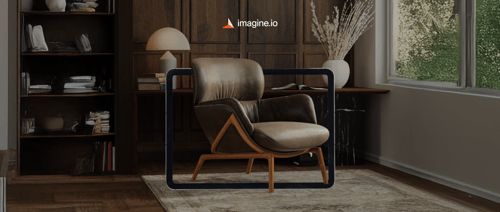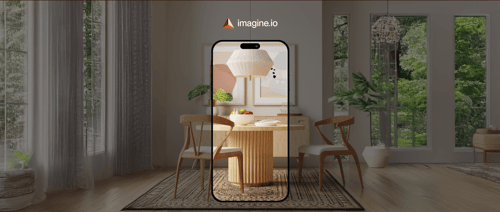Imagine a shopper in Los Angeles browsing an online furniture store, rotating a sleek sectional sofa 360 degrees, switching its fabric from linen to leather, and placing it virtually in their living room with augmented reality. This isn't a sci-fi dream it's the new reality for home goods eCommerce. Visual content is the lifeblood of online retail, but traditional photoshoots drain budgets and slow down launches. Subscription-based 3D visualization platforms, like imagine.io, are rewriting the rules, delivering unmatched ROI for furniture, home décor, and textile brands across the U.S. and Canada. With the visual content market valued at $8.24 billion in 2024 and projected to hit $19.10 billion by 2033 at a 9.8% CAGR, the shift to smarter, scalable solutions is undeniable.
Emerging Trends Reshaping Visual Content Creation
Moving Beyond Traditional Photography to CGI
Setting up a photoshoot for a single furniture collection can cost thousands think studio rentals, lighting crews, and shipping logistics. Then add weeks of post-production. AI-powered 3D rendering flips this model on its head, cutting costs by up to 70%. Platforms like imagine.io produce photorealistic images that rival real-world shoots, with studies showing eCommerce leaders can't tell the difference. For brands in competitive hubs like New York or Chicago, this means high-quality visuals without the hefty price tag, freeing up budgets for innovation.
Augmented Reality and Configurators Take Center Stage
Today's shoppers demand more than static images. They want to interact, customize, and visualize products in their own spaces. Augmented reality and eCommerce configurators meet this need, letting customers tweak colors, textures, or layouts in real-time. The result? Conversion rates can soar by 500%, as buyers gain confidence in their purchases. With smartphone adoption and faster internet driving demand for immersive experiences, as noted in industry reports, AR is no longer a luxury it's a necessity for home goods brands.
Cloud-Based Rendering for Speed and Scale
Large product catalogs are a blessing and a curse. While they offer variety, creating visuals for thousands of SKUs can be a nightmare. Cloud-based rendering changes that, enabling brands to upload 3D models and generate images, videos, or 360 spins in minutes. This scalability is a game-changer for retailers in fast-moving markets like Dallas or Las Vegas, where rapid launches are critical. Imagine.io's subscription model, with unlimited asset creation, ensures brands can keep up without breaking the bank.
Real-World Wins: How Brands Are Transforming
Furniture Brands Slash Launch Timelines
Picture a furniture brand racing to launch a new collection before a major trade show in High Point. Traditional methods prototyping, shooting, editing could take weeks. One imagine.io client turned this around in hours. By uploading 3D models to the cloud, they generated photorealistic images and interactive configurators, hitting the market faster than competitors. This speed didn't just save time; it drove early sales and strengthened their market position.
Home Décor Retailers Skyrocket Conversions
In the home décor space, buyer hesitation is a killer. A retailer in Austin tackled this by integrating imagine.io's 3D visuals and AR tools into their product pages. Shoppers could explore items from every angle, customize finishes, and see products in their homes via AR. The payoff? A 500% conversion rate boost, as customers felt confident enough to click “buy.” With digital content creation projected to reach $69.80 billion by 2033 at a 13.9% CAGR, these tools are reshaping how brands connect with consumers.
Textile Companies Boost Engagement with 360 Spins
For a textile brand, standing out means showcasing texture and detail. One imagine.io client introduced 360 spins to highlight fabric patterns, leading to longer site sessions and higher cart completions. By consolidating imagery, video, and interactive elements into one platform, they streamlined their workflow while delivering a richer customer experience. In a market where visuals drive decisions, this all-in-one approach is a competitive edge.
Navigating Challenges in Subscription Models
Decoding Custom Pricing Concerns
One sticking point for brands is pricing complexity. Unlike competitors with one-size-fits-all packages, imagine.io offers tailored pricing to match each client's needs. While this can seem overwhelming, it ensures brands only pay for what they use. Clear ROI metrics like 70% cost savings or 500% conversion uplifts make the case for custom plans, especially for companies with diverse catalogs.
Subscription vs. One-Off Projects
Some brands balk at ongoing subscriptions, preferring the familiarity of project-based work. But subscriptions offer flexibility and predictability, especially for dynamic catalogs. Imagine.io's unlimited asset creation eliminates the cost creep of per-project fees, making it ideal for brands scaling in markets like Los Angeles or Canada. The shift requires a mindset change, but the long-term savings are hard to ignore.
Building Trust with Proven Quality
For companies loyal to traditional agencies, trusting a newer platform can feel risky. Yet imagine.io's ability to match photoshoot quality down to the smallest detail sets it apart. Studies show its CGI assets are indistinguishable from real photos, and its all-in-one capabilities (images, videos, AR, configurators) make it a versatile partner. For brands in furniture hubs like High Point, this reliability builds confidence in a new vendor.
Seizing Opportunities for Growth
Scaling Visuals for Every SKU
Managing visuals for thousands of products is daunting. Subscription-based platforms like imagine.io solve this with unlimited asset creation, ensuring every SKU has compelling visuals. This completeness drives sales in competitive regions like Chicago or Dallas, where robust product pages are non-negotiable.
Accelerating Market Launches
Speed is everything in eCommerce. AI-powered platforms enable brands to roll out seasonal collections or promotions in days, not weeks. A textile brand, for example, can generate lifestyle imagery and 360 spins for a new line almost instantly, staying ahead of trends and competitors.
Streamlining Creative Workflows
Juggling vendors for images, videos, and AR is a recipe for chaos. An all-in-one platform consolidates these tasks, letting creative teams focus on strategy. This efficiency sparks innovation, allowing brands to experiment with bold, interactive content that captivates shoppers across platforms like LinkedIn, Instagram, and YouTube.
Measuring ROI: The Numbers That Matter
ROI isn't just a buzzword it's measurable. First, cost savings: platforms like imagine.io reduce expenses by up to 70% compared to traditional photoshoots. Second, conversions can jump 500% with AR and configurators, as buyers gain confidence. Third, creative teams save time, producing assets faster without sacrificing quality. Finally, faster inventory turnover cuts warehousing costs and boosts cash flow. These metrics, rooted in real results, prove the value of AI-driven solutions.
A Future-Ready Path for Home Goods Brands
The home goods industry is at a tipping point. As consumers demand richer, more interactive online experiences, brands must evolve or get left behind. With the subscription box market set to hit $116.2 billion by 2033 at a 13.3% CAGR, and visual content creation booming, the case for AI-powered platforms is clear. For furniture, home décor, and textile brands in cities like New York, Austin, or beyond, imagine.io offers a smarter way to scale, save, and sell. The future of eCommerce is visual, and the time to invest is now.
Frequently Asked Questions
How much can home goods brands save by switching from traditional photography to AI-powered 3D rendering?
Home goods brands can reduce their visual content creation costs by up to 70% by switching from traditional photography to AI-powered 3D rendering platforms like imagine.io. This dramatic cost savings comes from eliminating expensive studio rentals, lighting crews, shipping logistics, and weeks of post-production work that traditional photoshoots require.
How do AR and 3D configurators impact conversion rates for furniture and home décor brands?
AR and 3D configurators can boost conversion rates by up to 500% for home goods brands. These interactive tools allow customers to customize colors, textures, and layouts in real-time, and visualize products in their own spaces through augmented reality, significantly increasing buyer confidence and reducing purchase hesitation.
What are the main benefits of subscription-based visual content platforms for home goods eCommerce?
Subscription-based visual content platforms offer unlimited asset creation, faster time-to-market (generating visuals in minutes instead of weeks), scalability for large product catalogs, and consolidated workflows that combine images, videos, AR experiences, and configurators in one platform. This approach provides predictable costs and eliminates the expense creep of per-project fees while enabling brands to keep up with dynamic inventory changes.
Disclaimer: The above helpful resources content contains personal opinions and experiences. The information provided is for general knowledge and does not constitute professional advice.
You may also be interested in: Imagine.io | Award Winning 3D + AI Product Visualization
Struggling with expensive, outdated product visuals that slow down your creative process and stunt eCommerce growth? imagine.io's AI-powered platform empowers furniture, home décor, and textile brands to effortlessly produce striking 3D images, immersive videos, AR experiences, and interactive configurators. Cut production costs up to 70%, boost conversions 5X, speed up prototyping, and supercharge your online sales. Ready to elevate your product visuals and captivate customers? Book a demo with imagine.io today!
Powered by flareAI.co




.png?width=500&name=How%20to%20Add%20a%203D%20Product%20Configurator%20to%20Your%20WordPress%20Website%20(Complete%20B2B%20Guide).png)
















%20(1).png?width=500&name=Why%20Exploded%20Mattress%20Views%20Matter%20(And%20How%20to%20Generate%20Them)%20(1).png)
.png?width=500&name=Best%20Shopify%20Product%20Configurator_%20How%20to%20Choose%20the%20Right%20One%20(2).png)
.png?width=500&name=Why%20Exploded%20Mattress%20Views%20Matter%20(And%20How%20to%20Generate%20Them).png)



.png?width=500&name=Best%20Shopify%20Product%20Configurator_%20How%20to%20Choose%20the%20Right%20One%20(1).png)







.png?width=500&name=How%203D%20Rendering%20Can%20Make%20or%20Break%20Your%20Industrial%20Design%20Pitch%20(1).png)








%20with%20Digital%20Twins%20and%203D%20Visualization.png?width=500&name=Optimizing%20Your%20Digital%20Asset%20Management%20(DAM)%20with%20Digital%20Twins%20and%203D%20Visualization.png)




.png?width=500&name=Styling%20Home%20Decor%20for%202025_%20From%20Global%20Influences%20to%20Playful%20Personalization%20(1).png)
